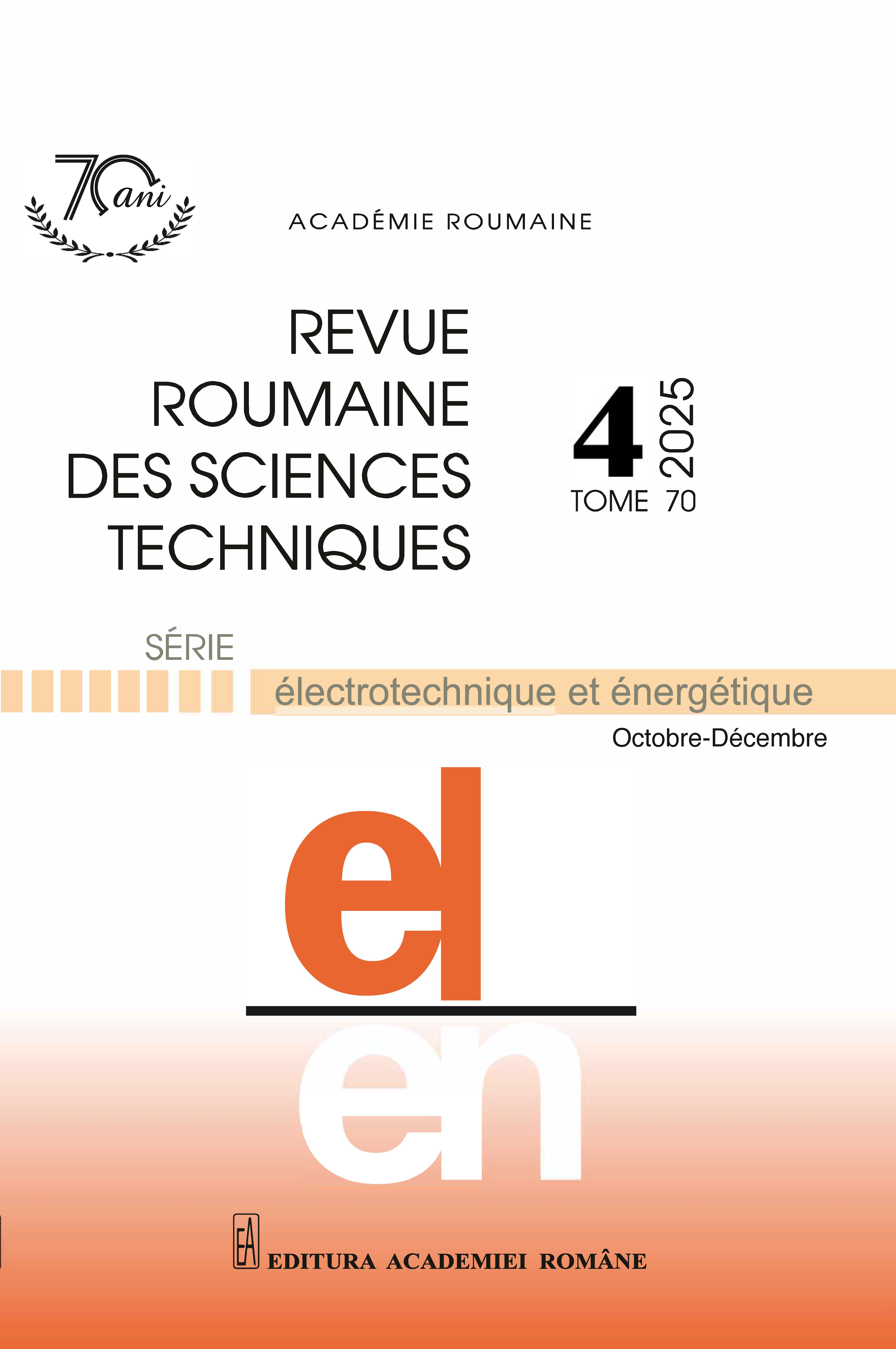ÉLECTROPERMÉABILISATION DES MATÉRIAUX ORGANIQUES – MODÉLISATION NUMÉRIQUE
DOI :
https://doi.org/10.59277/RRST-EE.2025.4.28Mots-clés :
Électroperméabilisation (EP), Champ électrique, Conductivité électrique, Transfert de chaleur, Méthode des éléments finis (MEF)Résumé
L'électroporation, également appelée électroperméabilisation (EP), se produit lorsque le potentiel transmembranaire d'une cellule dépasse un seuil critique sous l'influence d'un champ électrique, correspondant à une valeur limite de l'intensité du champ. L'EP dépend de la distribution du champ électrique, qui, à son tour, dépend des propriétés électriques du matériau et les détermine dans ce cas précis. Certaines intensités critiques du champ électrique agissent comme un « interrupteur » pour l'EP, qui est, dans une certaine mesure, réversible. Cet article vise, à travers des expériences numériques, à dévoiler les effets du champ électrique sur la poration d'une substance organique (lavande) et sur la stabilité thermique de la cellule EP. La substance est supposée être un milieu continu avec des propriétés matérielles dépendantes du champ électrique.
Références
(1) T. Kotnik, W. Frey, M. Sack, S. Haberl Meglič, M. Peterka, D. Miklavčič, Electroporation-based applications in biotechnology, Trends Biotechnol., 33, 8, pp. 480–488 (Aug. 2015).
(2) E. Demir, S. Tappi, K. Dymek, P. Rocculi, F. Gómez Galindo, Reversible electroporation caused by pulsed electric field – Opportunities and challenges for the food sector, Trends Food Sci. Technol., 139, p. 104120 (2023).
(3) K. A. DeBruin, W. Krassowska, Modeling electroporation in a single cell: Effects of field strength and rest potential, Biophys. J., 77, 3, pp. 1213–1224 (Sep. 1999).
(4) T. Kotnik, G. Pucihar, M. Rebersek, D. Miklavčič, L.M. Mir, Role of pulse shape in cell membrane electropermeabilization, Biochim. Biophys. Acta, 1614, 2, pp. 193–200 (Aug. 2003).
(5) C.I. Mocanu, Electromagnetic Field Theory, (in Romanian) E.D.P., Bucharest (1982).
(6) T.T.N. Vu, G. Teyssedre, S. Le Roy, C. Laurent, Maxwell–Wagner effect in multi-layered dielectrics: interfacial charge measurement and modelling, Technologies, 5, 27 (2017).
(7) H.P. Schwan, Electrical properties of tissue and cell suspensions, Advances in biological and medical physics, 5, pp. 147-209 (1957).
(8) K.R. Foster, H.P. Schwan, Dielectric properties of tissues and biological materials: a critical review, Critical reviews in biomedical engineering, 17, 1, pp. 25-104 (1989).
(9) L. Bao, W. Shang, Dielectric Properties of Biological Tissues: A Review. Sensors, 18, 5, 1433, (2018).
(10) K. Dymek, P. Dejmek, F. Gomez Galindo, Influence of pulsed electric field protocols on the reversible permeabilization of rucola leaves, Food and Bioprocess Technology, 7, 3, pp. 761–773 (2014).
(11) E. Vorobiev, N. Lebovka, Pulsed-Electric-Fields-Induced Effects in Plant Tissues: Fundamental Aspects and Perspectives of Applications, in Electrotechnologies for Extraction from Food Plants and Biomaterials, Springer, New York, pp. 39–81, NY(2008).
(12) J. Kulbacka, L.M. Frey, M. Kotulska, Electroporation in biological membranes: Theory and applications, in Advances in Biomembranes and Lipid Self-Assembly, 29, pp. 65–110, Academic Press (2019).
(13) B. Gabriel, J. Teissié, Direct observation in the millisecond time range of fluorescent molecule asymmetrical interaction with the electropermeabilized cell membrane, Biophysical Journal, 73, 5, pp. 2630–2637 (1997).
(14) K. Dymek, P. Dejmek, F. Gomez Galindo, Influence of pulsed electric field protocols on the reversible permeabilization of rucola leaves, Food and Bioprocess Technology, 7, 3, 761–773 (2014).
(15) T.T.N. Vu, G. Teyssedre, S. Le Roy, C. Laurent, Maxwell–Wagner effect in multi-layered dielectrics: interfacial charge measurement and modelling, Technologies, 5, 27 (2017).
(16) A. Çınar , K. Ateş , L.N.Ö. Polat , S. Elmasulu , I.K. Oğuz , O. Çınar, Ş. Özen, Adulteration control of lavender essential oil by using its electrical properties in the low-frequency range, Measurement Science Review, 25, 3, pp. 141–147 (2025).
(17) K. Kurata, M. Matsushita, T. Yoshii, T. Fukunaga, H. Takamatsu, Effect of irreversible electroporation on three-dimensional cell culture model, Proc. Annu. Int. Conf. IEEE Eng. Med. Biol. Soc. (EMBC), San Diego, CA, USA, pp. 179–182 (2012).
(18) ***Comsol a.b., www.comsol.com.
(19) F. Guo, X. Nie, J. Hong, Y. Zhang, J. Sun, Influence of Joule heating during single-cell electroporation simulation under IRE and H-FIRE pulses, Materials Today Communications, 33, p. 104358 (2023).
(20) S. Najafian, The effect of time and temperature on the shelf life of essential oils of Lavandula officinalis, J. of Essential Oil Research, 28, 5, pp. 413–420 (2016).
(21) K. Kurata, M. Matsushita, T. Yoshii, T. Fukunaga, H. Takamatsu, Effect of irreversible electroporation on three-dimensional cell culture model, in Proc. Annu. Int. Conf. IEEE Eng. Med. Biol. Soc. (EMBC), San Diego, CA, USA, pp. 179–182 (2012).
Téléchargements
Publiée
Numéro
Rubrique
Licence
(c) Copyright REVUE ROUMAINE DES SCIENCES TECHNIQUES — SÉRIE ÉLECTROTECHNIQUE ET ÉNERGÉTIQUE 2025

Ce travail est disponible sous licence Creative Commons Attribution - Pas d'Utilisation Commerciale - Pas de Modification 4.0 International.


